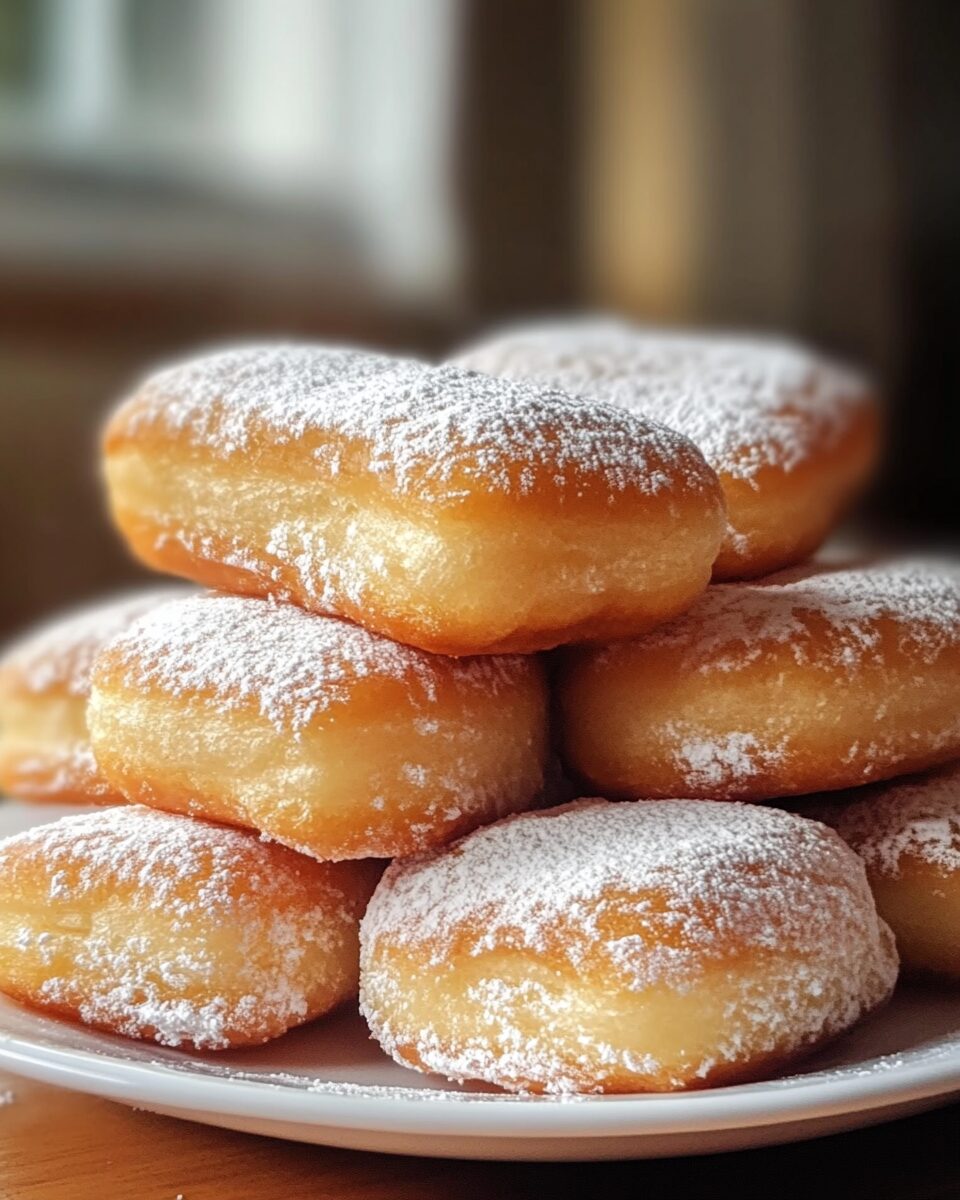Vanilla French Beignets are a delightful French pastry, known for their light and airy texture with a hint of vanilla flavor. These golden, pillowy treats are dusted with powdered sugar, making them a perfect indulgence for breakfast, dessert, or a sweet snack.
FULL RECIPE:
Ingredients
For the Beignet Dough:
- 3 ½ cups all-purpose flour
- ¼ cup granulated sugar
- 1 teaspoon active dry yeast
- 1 cup warm milk (about 110°F)
- 2 large eggs
- 1 teaspoon vanilla extract
- ¼ cup unsalted butter, melted
- 1 teaspoon salt
- Vegetable oil, for frying
For the Topping:
- Powdered sugar, for dusting
Directions
-
Activate the Yeast: In a small bowl, combine the warm milk and active dry yeast. Stir gently and let it sit for about 5-10 minutes until frothy.
-
Prepare the Dough: In a large mixing bowl, whisk together the all-purpose flour, granulated sugar, and salt. Create a well in the center and add the yeast mixture, eggs, melted butter, and vanilla extract. Stir until a sticky dough forms.
-
Knead the Dough: Transfer the dough onto a lightly floured surface and knead for about 5-7 minutes until smooth and elastic.
-
First Rise: Place the dough in a greased bowl, cover it with a clean kitchen towel, and let it rise in a warm place for about 1-1.5 hours, or until it has doubled in size.
-
Shape the Beignets: Once the dough has risen, punch it down to release any air bubbles. Transfer it back to the floured surface and roll it out to about ½-inch thickness. Use a pizza cutter or a sharp knife to cut the dough into squares, roughly 2×2 inches.
-
Heat the Oil: Heat vegetable oil in a large pot or deep skillet to 350°F (175°C).
-
Fry the Beignets: Fry 3–4 beignets at a time, being careful not to overcrowd the pot. Fry for 1–2 minutes on each side, until golden brown. Use a slotted spoon to remove them and place them on a paper towel-lined plate to drain excess oil.
-
Dust and Serve: Generously dust the warm beignets with powdered sugar and serve immediately.
Nutrition Facts
- Calories: 150
- Protein: 2g
- Carbohydrates: 18g
- Fat: 7g
The History of Beignets
Beignets have a rich history that dates back to ancient Rome, where fried dough treats were commonly enjoyed. However, the beignets we know today are deeply rooted in French cuisine. The term “beignet” is derived from the Old French word “bignet,” meaning a small fritter. French settlers brought beignets to the United States, specifically to Louisiana, where they became an integral part of New Orleans’ culinary culture. Over time, these pastries have evolved, incorporating different flavors, fillings, and toppings, making them a versatile and beloved treat worldwide.
What Makes Vanilla French Beignets Special?
Unlike traditional plain beignets, Vanilla French Beignets stand out due to the addition of vanilla extract, which imparts a distinct and comforting sweetness. The vanilla enhances the flavor profile, making each bite more aromatic and indulgent. The dough itself is enriched with butter and eggs, resulting in a slightly chewy interior that contrasts beautifully with the crisp exterior. When fried to perfection, these beignets are light, fluffy, and practically melt in your mouth. The final touch of powdered sugar not only adds sweetness but also creates an elegant, snow-like finish that makes them visually appealing.
The Cultural Significance of Beignets
Beignets hold a special place in both French and American culinary traditions. In France, they are often associated with celebrations such as Mardi Gras and are commonly found in bakeries and cafes. In New Orleans, they have become a symbol of the city’s vibrant food scene, famously served at the renowned Café du Monde. These pastries are often enjoyed as part of breakfast or as a mid-day snack, accompanied by chicory coffee or café au lait. The simple yet delicious nature of beignets has allowed them to transcend cultural boundaries, becoming a popular treat in various parts of the world.
Tips for Making the Perfect Beignets
Achieving the perfect beignet requires a few key techniques. First, ensuring the yeast is properly activated is crucial for creating a light and airy texture. Allowing the dough to rise sufficiently will also contribute to its fluffiness. When frying, maintaining the right oil temperature is essential—too hot, and the beignets will brown too quickly without cooking through; too cool, and they will absorb excess oil, becoming greasy. Lastly, serving them fresh is the best way to enjoy their delicate texture and warm, aromatic flavor. While they can be reheated, nothing compares to a freshly fried beignet straight from the pan.
Serving Suggestions and Pairings
Vanilla French Beignets are delicious on their own, but they can be paired with various accompaniments to enhance the experience. A side of chocolate or caramel sauce adds richness, while fresh berries bring a touch of tartness that balances the sweetness. A dollop of whipped cream or a drizzle of honey can also elevate their flavor. Beignets pair exceptionally well with hot beverages such as coffee, espresso, or even hot chocolate, making them an ideal morning indulgence or a comforting afternoon treat.
Variations of Beignets Around the World
While French-style beignets are widely recognized, many cultures have their own versions of fried dough treats. In Italy, zeppole are light, airy fritters often dusted with powdered sugar or filled with custard. Spanish churros, another popular variation, are elongated and coated with cinnamon sugar, typically served with thick hot chocolate. In South America, buñuelos are a common treat, made with cheese-infused dough and fried until golden. Each of these variations showcases how different regions have adapted the concept of fried dough, incorporating unique flavors and ingredients to create their own signature delights.
Health Considerations and Nutritional Information
While beignets are undoubtedly a delightful indulgence, they should be enjoyed in moderation due to their calorie and fat content. The deep-frying process adds to their richness, making portion control essential for those mindful of their diet. However, there are ways to make them slightly healthier. Using alternative flours, reducing the sugar content, or even baking them instead of frying can result in a lighter version. Regardless of modifications, beignets remain a treat best enjoyed as part of a balanced diet.
Why You Should Try Vanilla French Beignets
If you love pastries that are light, crispy, and bursting with flavor, Vanilla French Beignets are a must-try. Their delicate balance of sweetness and texture makes them a versatile treat, suitable for various occasions. Whether you’re making them for a weekend brunch, a festive celebration, or simply to satisfy a sweet craving, these beignets are sure to impress. The joy of making them from scratch is also a rewarding experience, allowing you to appreciate the craftsmanship behind this classic pastry.
Conclusion
Vanilla French Beignets are a timeless treat that combines simplicity with indulgence. Their rich history, cultural significance, and delightful flavor make them a beloved pastry across different regions. Whether you enjoy them with a hot cup of coffee, paired with a dipping sauce, or simply dusted with powdered sugar, these beignets are a guaranteed crowd-pleaser. By making them at home, you get to experience the magic of freshly fried dough infused with the comforting essence of vanilla. Give this recipe a try, and let the delicate, golden pillows of goodness transport you to a world of French-inspired sweetness.






